My first gourd project was probably a bit ambitious for a beginner, but the little toads that visit my deck on a nightly basis inspired me.
I don't care much about the stains caused by the weathering of the gourd. I think they add character. Besides, I don't yet have stain or dye for adding color, so. . . But anyway, below is is a photographic journey taking you through the process of my gourdy adventure almost from start to finish.
I do wish I had had the insight to take pictures from the very beginning, but alas. I picked a gourd--from my 37--that was medium in size, fairly straight, and well-balanced. (The balance part didn't really seem important until recently when I was cleaning more gourds and noticed that two of them don't sit very well.) It was also pretty clean compared to some of the other ones in the bunch.
To clean the outside of the gourd I just used my kitchen sink. I filled it with water, a little bit of dish soap, and bleach. The bleach not only helps with the removal of mold spots, it also bleaches them out a bit, adding some consistency to the color. An extra benefit is the antifungal and antimicrobial benefits that will last long after the gourd has dried.
The cleaning action needs to be abrasive, so I used steel wool. I had some some issues, the most annoying of which was the smell. Steel wool stinks when it gets wet. It also rusts almost instantly, which feels really gross on bare hands. (For the next batch of gourds, I used copper pads for scrubbing pans. And rubber gloves.) But the steel wool worked for my impatience.
Once the gourd was dry, I drew the door and bottom hole for my toad house.
+Door+Drawn.JPG) |
| Toad House Door |
Then I drilled guide holes for sawing the pieces out.
Lots of guide holes.
+Starter+Holes+on+Bottom.jpg) |
| Guide Holes for Bottom Hole |
I used an Exacto hand saw to cut out the base. It was tedious work that would be
much easier with a power handheld jig saw. But that's why I drilled so many guide holes.
Inside the gourd can be a number of different types of yucky seed and guts material. This gourd wasn't too bad, as most of the yucky stuff just dumped out. This being my first time, I tried a few different things for cleaning out the remaining yuck. I soaked and scraped. I scraped it dry. I sanded. In the end, I decided that it's only a toad house and doesn't have to be perfect. (I've found other tools used with a power drill that will
really clean out the insides.)
+Bottom+Cut.jpg) |
| Base Hole |
+Starter+Holes+on+Door+w:Bug+(2).jpg) |
| Bug with the Gourd |
+Starter+Holes+on+Door+w:Bug+(1).jpg) |
| Bug with the Gourd |
+Starter+Holes+on+Door+w:Bug+(3).jpg) |
| Checking Out the Holes |
+Starter+Holes+on+Door+w:Bug+(4).jpg) |
| Silly Boy |
I cut the hole for the door the same way. Then I scraped the inside some more.
+Door+Cut+(1).jpg) |
| Door Hole (no flash) |
+Door+Cut+(2).jpg) |
| Door Hole (with flash) |
I drew a few windows in different shapes before settling on two ovals on the sides and a circle in the top center. (Here I must toot my horn: I drew that circle freehand the first time. **smiles**) I thought the door looked a little naked, so I sketched some "stone" work around it.
After waiting a while, looking at the pencil marks on my gourd, I finally broke out the wood burner. After getting halfway around the door, I was informed that the odor was noticeable by the steps. (I was so impatient, I started burning at the dining room table around 11 o'clock one night.) The next day I sat under the ceiling fan in the sunroom and finished tracing my pencil lines with the tapered burning tip. (An observation: The tapered point, while giving a fine line for more detail, is better for those finer details than outlines. It's just not quite dark enough.)
+Door+&+Windows+Burned+(1).jpg) |
| Door & Center Window Burned |
+Door+&+Windows+Burned+(2).jpg) |
| Door & Center Window Burned |
+Door+&+Windows+Burned+(3).jpg) |
Side Window Burned
(with penciled pickets) |
+Door+&+Windows+Burned+(4).jpg) |
Side Window Burned
(with penciled pickets) |
I used the tapered point to burn the pickets in the circular window in order to keep it's delicacy. But the oval windows needed pickets with more umph. I really just wanted them to be wider, so I used the calligraphy tip. It was the perfect width for the pickets, but they came out a little dark and with a striped look. It's okay for a beginner, but next time I'll try to outline and shade them instead.
+Window+Pickets+Burned+(1).jpg) |
| Pickets Burned in Windows |
+Window+Pickets+Burned+(2).jpg) |
| Pickets Burned in Wind |
+Basic+Design+Finished+(1).jpg) |
| First Showcase Photo |
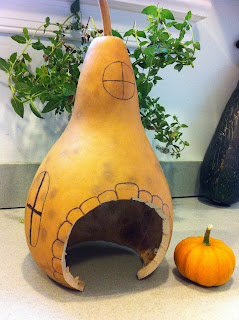+Basic+Design+Finished+(2).jpg) |
| Showcase with a Pumpkin |
I thought it still looked naked. Like it needed something in that big empty space between the door and the top window. I pictured a vine draping around the bottom of the neck like a scarf. But I have issues with symmetry in art, so I didn't want a vine hanging on each side of the door. A piece in the middle would solve that problem. It was a bit complicated, but I got it so there were no stray pieces that had no source. The source then be came an issue, so. . .
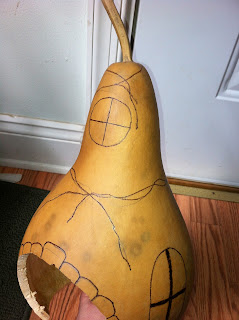+Vines+Burned+(1).jpg) |
| Vines Burned |
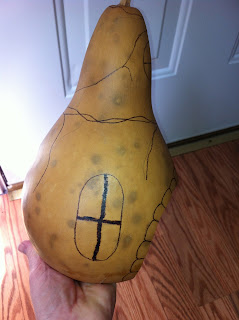+Vines+Burned+(3).jpg) |
| Vines Burned |
. . . I trailed the vines down to the base of the gourd, fattening them up at the bottom. This was they look like they're
growing around the toad house instead of just draped around the neck like a scarf.
+Vines+Burned+(2).jpg) |
| Source of Vines Burned |
Obviously, the vines look slightly puny--and like I burned a bunch of scraggly lines all over the gourd--with any leaves. Leaves could be hard. However, there is a burning tip that is used for shading, and it just happens to be shaped like a leaf. My idea was to use the flat side to burn leaves onto my vines, and I am super happy with the results.
+Leaves+Burned+(1).jpg) |
| Front View with Leaves Burned |
+Leaves+Burned+(3).jpg) |
| Stage Left with Leaves Burned |
+Leaves+Burned+(2).jpg) |
Stage Right with Leaves Burned
(This is my favorite side.) |
+Leaves+Burned+(4).jpg) |
| Rear View with Leaves Burned |
I had to pose it on my hutch with my Autumn gourds. . .
+Hutch+Pose+(4).jpg)
But it still wasn't finished. The door and bottom hole needed to be filed smooth. You may have noticed the chip mark in the keystone above the door. That was a drill hole, and I wanted it gone. But, I couldn't fine my small rasps for just such a purpose. It took me searching through Hubby's tool box--where last I saw said rasps--for him to help me look. He didn't find my flat ones, but he did find a round one. Beggars can't be choosers, so I made do. It worked pretty well. I was able to smooth the sharp and rough edges along the openings, and did a decent job with the chip in the keystone.
My toad house also needed a good rub down with mineral oil to protect it from the elements. To this point I have done three applications, but there are still areas where I can see that it needs more. (Gourds can have different rates of absorption across the shell. They can also be harder to burn in different areas, like around the stem.) The inside being the most absorbent part, I actually poured the oil inside, rolled it around for more even coating, and rubbed it in. The slight sheen you can see in the pictures below is from the oil.
So, aside from a few more coats of mineral oil, my first gourd project is complete! Below I have pictures of it in it's "natural" element. . . the garden. I hope you liked it. I am very proud of myself for this accomplishment. I couldn't be happier.
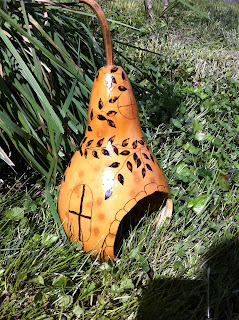+Finished+Toad+Hous+in+Garden+(1).jpg) |
| In Sun |
+Finished+Toad+Hous+in+Garden+(2).jpg) |
| In Sun |
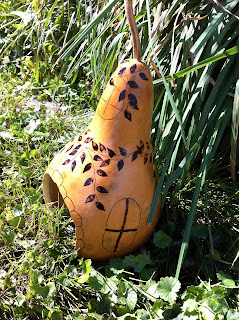+Finished+Toad+Hous+in+Garden+(3).jpg) |
| In Sun |
++Finished+Toad+Hous+in+Garden+(4).jpg) |
| In Sun |
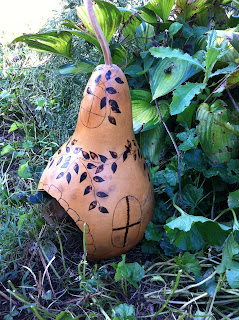++Finished+Toad+Hous+in+Garden+(6).jpg) |
| In Shade |
++Finished+Toad+Hous+in+Garden+(7).jpg) |
| In Shade |
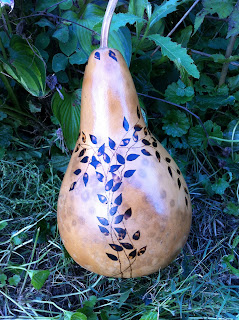++Finished+Toad+Hous+in+Garden+(8).jpg) |
| In Shade |
++Finished+Toad+Hous+in+Garden+(5).jpg) |
| In Shade |
+Starter+Holes+on+Bottom.jpg)
+Bottom+Cut.jpg)
+Starter+Holes+on+Door+w:Bug+(2).jpg)
+Starter+Holes+on+Door+w:Bug+(1).jpg)
+Starter+Holes+on+Door+w:Bug+(3).jpg)
+Starter+Holes+on+Door+w:Bug+(4).jpg)
+Hutch+Pose+(4).jpg)
+Door+Cut+(1).jpg)
+Door+Cut+(2).jpg)
+Door+&+Windows+Burned+(1).jpg)
+Door+&+Windows+Burned+(2).jpg)
+Door+&+Windows+Burned+(3).jpg)
+Door+&+Windows+Burned+(4).jpg)
+Window+Pickets+Burned+(1).jpg)
+Window+Pickets+Burned+(2).jpg)
+Basic+Design+Finished+(1).jpg)
+Basic+Design+Finished+(2).jpg)
+Vines+Burned+(1).jpg)
+Vines+Burned+(3).jpg)
+Vines+Burned+(2).jpg)
+Leaves+Burned+(1).jpg)
+Leaves+Burned+(3).jpg)
+Leaves+Burned+(2).jpg)
+Leaves+Burned+(4).jpg)
+Hutch+Pose+(3).jpg)
+Hutch+Pose+(4).jpg)
+Finished+Toad+Hous+in+Garden+(1).jpg)
+Finished+Toad+Hous+in+Garden+(2).jpg)
+Finished+Toad+Hous+in+Garden+(3).jpg)
++Finished+Toad+Hous+in+Garden+(4).jpg)
++Finished+Toad+Hous+in+Garden+(6).jpg)
++Finished+Toad+Hous+in+Garden+(7).jpg)
++Finished+Toad+Hous+in+Garden+(8).jpg)
++Finished+Toad+Hous+in+Garden+(5).jpg)
+Hutch+Pose+(1).jpg)
+Hutch+Pose+(6).jpg)